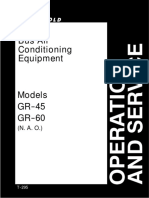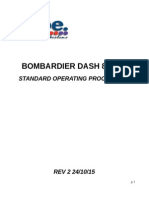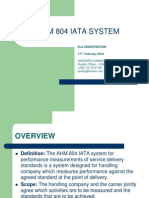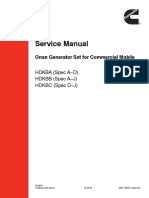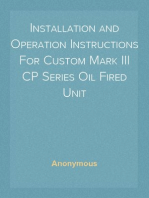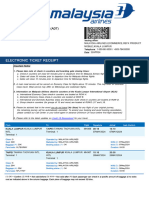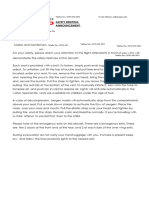C172S Checklist
C172S Checklist
Uploaded by
BrandonrjoCopyright:
Available Formats
C172S Checklist
C172S Checklist
Uploaded by
BrandonrjoOriginal Description:
Copyright
Available Formats
Share this document
Did you find this document useful?
Is this content inappropriate?
Copyright:
Available Formats
C172S Checklist
C172S Checklist
Uploaded by
BrandonrjoCopyright:
Available Formats
OKLAHOMA WING
NORMAL PROCEDURES
PREFLIGHT CHECK .................................................................N-1 BEFORE STARTING ENGINE ..................................................N-4 STARTING ENGINE WITH BATTERY ......................................N-5 STARTING ENGINE WITH EXTERNAL POWER .....................N-6 BEFORE TAXI ...........................................................................N-7 TAXI ...........................................................................................N-7 BEFORE TAKEOFF ..................................................................N-7 NORMAL TAKEOFF..................................................................N-8 SHORT FIELD TAKEOFF .........................................................N-8 ENROUTE CLIMB .....................................................................N-9 CRUISE......................................................................................N-9 DESCENT ..................................................................................N-9 BEFORE LANDING ...................................................................N-9 NORMAL LANDING ................................................................N-10 SHORT FIELD LANDING ........................................................N-10 GO AROUND ...........................................................................N-10 AFTER LANDING ....................................................................N-11 AIRCRAFT SHUTDOWN.........................................................N-12
Civil Air Patrol
EMERGENCY PROCEDURES
ENGINE FAILURE DURING TAKEOFF ROLL ......................... E-1 ENGINE FAILURE IMMEDIATELY AFTER TAKEOFF ............ E-1 ENGINE FAILURE DURING FLIGHT (RESTART) ................... E-1 EMERGENCY LANDING WITHOUT POWER .......................... E-2 PRECAUTIONARY LANDING WITH POWER.......................... E-2 DITCHING .................................................................................. E-3 ENGINE FIRE DURING START ON GROUND......................... E-4 ENGINE FIRE IN FLIGHT.......................................................... E-5 ELECTRICAL FIRE IN FLIGHT................................................. E-5 CABIN FIRE............................................................................... E-6 WING FIRE ................................................................................ E-6 ICING ......................................................................................... E-7 STATIC SOURCE BLOCKAGE ................................................ E-8 LANDING WITH FLAT MAIN TIRE ........................................... E-8 LANDING WITH FLAT NOSE TIRE .......................................... E-8 AMMETER SHOWS EXCESSIVE CHARGE............................. E-9 LOW VOLTAGE ANNUNCIATOR DURING FLIGHT................ E-9 VACUUM SYSTEM FAILURE ................................................. E-10
Cessna 172S Checklist N917CP
10 January 2010
OKLAHOMA WING
NORMAL PROCEDURES
PREFLIGHT CHECK .................................................................N-1 BEFORE STARTING ENGINE ..................................................N-4 STARTING ENGINE WITH BATTERY ......................................N-5 STARTING ENGINE WITH EXTERNAL POWER .....................N-6 BEFORE TAXI ...........................................................................N-7 TAXI ...........................................................................................N-7 BEFORE TAKEOFF ..................................................................N-7 NORMAL TAKEOFF..................................................................N-8 SHORT FIELD TAKEOFF .........................................................N-8 ENROUTE CLIMB .....................................................................N-9 CRUISE......................................................................................N-9 DESCENT ..................................................................................N-9 BEFORE LANDING ...................................................................N-9 NORMAL LANDING ................................................................N-10 SHORT FIELD LANDING ........................................................N-10 GO AROUND ...........................................................................N-10 AFTER LANDING ....................................................................N-11 AIRCRAFT SHUTDOWN.........................................................N-12
Civil Air Patrol
EMERGENCY PROCEDURES
ENGINE FAILURE DURING TAKEOFF ROLL ......................... E-1 ENGINE FAILURE IMMEDIATELY AFTER TAKEOFF ............ E-1 ENGINE FAILURE DURING FLIGHT (RESTART) ................... E-1 EMERGENCY LANDING WITHOUT POWER .......................... E-2 PRECAUTIONARY LANDING WITH POWER.......................... E-2 DITCHING .................................................................................. E-3 ENGINE FIRE DURING START ON GROUND......................... E-4 ENGINE FIRE IN FLIGHT.......................................................... E-5 ELECTRICAL FIRE IN FLIGHT................................................. E-5 CABIN FIRE............................................................................... E-6 WING FIRE ................................................................................ E-6 ICING ......................................................................................... E-7 STATIC SOURCE BLOCKAGE ................................................ E-8 LANDING WITH FLAT MAIN TIRE ........................................... E-8 LANDING WITH FLAT NOSE TIRE .......................................... E-8 AMMETER SHOWS EXCESSIVE CHARGE............................. E-9 LOW VOLTAGE ANNUNCIATOR DURING FLIGHT................ E-9 VACUUM SYSTEM FAILURE ................................................. E-10
Cessna 172S Checklist N906CP
10 January 2010
CESSNA 172S CHECKLIST
NORMAL PROCEDURES
PREFLIGHT INSPECTION
CABIN 1. 2. 3. 4. 5. 6. 7. Pitot Tube Cover - REMOVE, check opening for blockage Documents (AROW) - AVAILABLE IN THE AIRPLANE Aircraft Flight Log ENTER Hobbs and Tach Times Parking Brake - SET Control Wheel Lock - REMOVE Ignition Switch OFF, Key Removed Avionics Master Switch - OFF WARNING When turning on the master switch, using an external power source, or pulling the propeller through by hand, treat the propeller as if the ignition switch were on. Do not stand, nor allow anyone else to stand, within the arc of the propeller, since a loose or broken wire or a component malfunction could cause the propeller to rotate. Hand propped starts are prohibited by CAPR 60-1. 8. Master Switch - ON 9. Fuel Quantity Indicators - CHECK QUANTITY and 10. ENSURE LOW FUEL ANNUNCIATORS (L LOW FUEL R) ARE EXTINGUISHED 11. Avionics Master Switch - ON 12. Avionics Cooling Fan - CHECK AUDIBLY FOR 13. OPERATION 14. Avionics Master Switch - OFF 15. Static Pressure Alternate Source Valve - OFF 16. Annunciator Panel Switch - PLACE and HOLD IN TST 17. POSITION and ensure all annunciators illuminate 18. Annunciator Panel Test Switch - RELEASE. Check that appropriate annunciators remain on 19. Fuel Selector Valve - BOTH 20. Fuel Shutoff Valve - ON (Push Full In) 21. Flaps - EXTEND
22. Pitot Heat - ON (Carefully check that pitot tube is warm to touch within 30 seconds) 23. Beacon, Nav, Stobe, Landing, Taxi, Pulse Lights - CHECK 24. Pitot Heat - OFF 25. Master Switch - OFF 26. Baggage Compartment INVENTORY, SECURE CONTENTS - Tow Bar, Chocks, Pitot Tube Cover, Ladder, First Aid Kit, Tie Down Straps and Ropes, Survival Kit, Fuel Sampler, Cleaning Materials, 1 QT Oil, Landing/Taxi Light Bulbs, Avionics Control Lock. 27. Baggage Door CLOSED Lock with Key EMPENNAGE 1. Rudder Gust Lock (if installed) - REMOVE 2. Tail Tie-Down - DISCONNECT 3. Control Surfaces - CHECK freedom of movement and security 4. Trim Tab - CHECK security 5. Antennas - CHECK for security of attachment and general condition RIGHT WING Trailing Edge 1. 2. Flap - CHECK for security and condition Aileron - CHECK freedom of movement and security
RIGHT WING 1. Nav and Strobe Light CHECK VISUALLY 2. Wing Tie-Down - DISCONNECT 3. Main Wheel Tire - CHECK for proper inflation and general condition (38 PSI) 4. Fuel Tank Sump Quick Drain Valves - DRAIN small amount, check for water, sediment and proper fuel grade 5. Fuel Quantity - CHECK VISUALLY for desired level 6. Drained Fuel RETURN uncontaminated fuel to tank 7. Fuel Filler Cap SECURE and VENT UNOBSTRUCTED
NORMAL PROCEDURES
N-1
N-2
CESSNA 172S CHECKLIST
CESSNA 172S CHECKLIST
NORMAL PROCEDURES
NOSE 1. Fuel Strainer Quick Drain Valve (bottom of fuselage) DRAIN small amount, check for water, sediment and proper fuel grade 2. Engine Oil Dipstick/Filler Cap - CHECK oil level, then check dipstick/filler cap SECURE. Do not operate with less than 5 quarts. Fill to 8 quarts for extended flight 3. Engine Cooling Air Inlets - CLEAR of obstructions 4. Propeller and spinner - CHECK for nicks and security 5. Air Filter - CHECK for restrictions by dust 6. Nose wheel Strut and Tire - CHECK for proper inflation of strut and general condition of tire (45 PSI) 7. Left Static Source Opening - CHECK for stoppage LEFT WING 1. Fuel Tank Sump Quick Drain Valves - DRAIN small amount, check for water, sediment and proper fuel grade 2. Fuel Quantity - CHECK VISUALLY for desired level 3. Drained Fuel RETURN uncontaminated fuel to tank 4. Fuel Filler Cap - SECURE 5. Main Wheel Tire - CHECK for proper inflation and general condition (38 PSI) LEFT WING Leading Edge 1. 2. 3. 4. Fuel Tank Vent Opening - CHECK for stoppage Stall Warning Opening - CHECK for stoppage Wing Tie-Down - DISCONNECT Landing/Taxi Lights - CHECK for condition and cleanliness of cover 5. Nav and Strobe Light CHECK VISUALLY LEFT WING Trailing Edge 1. 2. Aileron - CHECK freedom of movement and security Flap - CHECK for security and condition
BEFORE STARTING ENGINE 1. 2. 3. Preflight Inspection - COMPLETE Chocks, Tiedowns, and Tow Bar RECHECK REMOVED Passenger Briefing - COMPLETE
Seat Belt Usage Emergency Egress procedures Fire Extinguisher Location Fire on Start Procedures Sterile Cockpit during Critical Phases of Flight No Tobacco Use Crew Comfort Items
4. 5. 6.
Seats, Belts, Shoulder Harnesses - ADJUST and LOCK Brakes - TEST and SET Circuit Breakers - CHECK IN CAUTION IF A CIRCUIT BREAKER IS NOT SET, DO NOT RESET THE CIRCUIT BREAKER IF THERE IS A RELATED MAINTENANCE MALFUNCTION
7.
Electrical Equipment, Autopilot (if installed) - OFF
CAUTION THE AVIONICS MASTER SWITCH MUST BE OFF DURING ENGINE START TO PREVENT POSSIBLE DAMAGE TO AVIONICS 8. Avionics Master Switch - OFF 9. Fuel Selector Valve - BOTH 10. Fuel Shutoff Valve - ON (Push Full In) CAUTION IF A CIRCUIT BREAKER IS NOT SET, DO NOT RESET THE CIRCUIT BREAKER IF THERE IS A RELATED MAINTENANCE MALFUNCTION 11. Avionics Circuit Breakers - CHECK IN 12. Rotating Beacon - ON
NORMAL PROCEDURES
N-3
N-4
CESSNA 172S CHECKLIST
CESSNA 172S CHECKLIST
NORMAL PROCEDURES
STARTING ENGINE (With Battery)
Throttle - OPEN 1/4 INCH Mixture - IDLE CUT OFF Propeller Area - CLEAR Master Switch - ON Auxiliary Fuel Pump Switch - ON Mixture - ADVANCE until fuel flow starts to rise, then return to IDLE CUT OFF position 7. Auxiliary Fuel Pump Switch OFF NOTE If engine is warm, omit priming procedure of steps 5, 6 and 7 above 8. Ignition Switch - START (RELEASE when engine starts) 9. Mixture - ADVANCE smoothly to RICH when engine fires NOTE If engine floods, turn off auxiliary fuel pump, place mixture in idle cut off, open throttle 1/2 to full, and crank the engine. When engine fires, advance mixture to full rich and retard throttle promptly 10. 11. 12. 13. 14. 15. Oil Pressure - CHECK Starter - CHECK DISENGAGED Ammeter - CHECK Navigation Lights - ON as required Avionics Master Switch - ON Radios - ON 1. 2. 3. 4. 5. 6.
8. Auxiliary Fuel Pump Switch OFF NOTE If engine is warm, omit priming procedure of steps 6, 7 and 8 above 9. Ignition Switch - START (RELEASE when engine starts) 10. Mixture - ADVANCE smoothly to RICH when engine fires NOTE If engine floods, turn off auxiliary fuel pump, place mixture in idle cut off, open throttle 1/2 t o full, and crank the engine. When engine fires, advance mixture to full rich and retard throttle promptly 11. 12. 13. 14. 15. 16. 17. Oil Pressure - CHECK Starter - CHECK DISENGAGED Ammeter - CHECK External Power - DISCONNECT from airplane receptacle Navigation Lights - ON as required Avionics Master Switch - ON Radios - ON
STARTING ENGINE (With External Power)
1. 2. 3. 4. 5. 6. 7. Throttle - OPEN 1/4 INCH Mixture - IDLE CUT OFF Propeller Area - CLEAR External Power - CONNECT to airplane receptacle Master Switch - ON Auxiliary Fuel Pump Switch - ON Mixture - ADVANCE until fuel flow starts to rise, then return to IDLE CUT OFF Position
NORMAL PROCEDURES
N-5
N-6
CESSNA 172S CHECKLIST
CESSNA 172S CHECKLIST
NORMAL PROCEDURES
BEFORE TAXI
1. Manual Electric Trim (MET) CHECK (KLN-94 AUTOPILOT ONLY) a. Left trim switch up and down, no movement b. Right trim switch up and hold for 5 seconds, no movement and PT light on KAP 140. Repeat for down position. c. Both trim switches up, watch for nose up movement. d. Both trim switches down, watch for nose down movement. Press and hold TRIM INTERUPT/AUTOPILOT DISCONNECT Switch. Movement should stop. Release disconnect switch and look for movement to resume 2. Autopilot ON (KLN-89/94 AUTOPILOT) a. FLIGHT CONTROLS MOVE (Make sure that the autopilot can be overpowered in both axes. b. A/P DISC/TRIM INT Switch PUSH (Make sure that the autopilot disengages. Make sure that the disengagement warning sound is heard. c. Autopilot Confirm OFF 3. Flaps RETRACT 4. Engine LEAN for Taxi
BEFORE TAKEOFF
1. 2. 3. 4. 5. 6. 7. 8. 9. 10. 11. Parking Brake SER Passenger Seat Backs MOST UPRIGHT POSITION Seats and Seat Belts CHECK SECURE Cabin Doors CLOSED and LOCKED Flight Controls FREE and CORRECT Flight Instruments CHECK and SET Fuel Quantity CHECK Mixture RICH Fuel Selector Valve RECHECK BOTH Elevator Trim SET for Takeoff Throttle 1800 RPM a. Magnetos CHECK (RPM drop should not exceed 150 RPM on either magneto or 50 RPM differential between magnetos) b. Suction Gage CHECK c. Engine Instruments and Ammeter CHECK Annunciator Panel No annunciators illuminated Throttle CHECK IDLE Throttle 1000 RPM or LESS Throttle Friction Lock ADJUST Pulse Light and Strobe Lights ON/AS DESIRED Radios and Avionics - SET Transponder Set Code and ALT NAV/GPS Switch SET Autopilot OFF Wing Flaps SET for Takeoff Takeoff Checklist - REVIEWED
Vr 55 KIAS Vx 62 KIAS Vy 74 KIAS Best Glide 70 KIAS Heading/Altitude After Takeoff - REVIEW
TAXI
1. 2. 3. Brakes - CHECK Nose Wheel Steering - CHECK Cross Wind Controls APPLY
12. 13. 14. 15. 16. 17. 18. 19. 20. 21. 22.
23. Takeoff Emergencies Briefing COMPLETE
ENGINE FAILURE OR SYSTEM MALFUNCTION Before Vr: Stop Aircraft on Runway After Vr: Land on remaining runway or straight ahead with only small turns. Flaps as necessary to slow touchdown speed
24. Brakes RELEASE
NORMAL PROCEDURES
N-7
N-8
CESSNA 172S CHECKLIST
CESSNA 172S CHECKLIST
NORMAL PROCEDURES
TAKEOFF
NORMAL TAKEOFF 1. 2. 3. 4. 5. Wing Flaps - 0-10 Throttle - FULL OPEN Mixture RICH (above 3000 feet, LEAN to obtain maximum RPM) Elevator Control - LIFT NOSE WHEEL (at 55 KIAS) Climb Speed 70-80 KIAS
CRUISE
1. Power - 2100-2700 RPM (no more than 75% is recommended) 2. Elevator Trim - Adjust 3. Mixture - LEAN
DESCENT
1. Power - AS DESIRED 2. Mixture - ADJUST for smooth operation 3. Fuel Selector Valve - BOTH
Short Field Takeoff 1. 2. 3. 4. 5. 6. 7. Wing Flaps - 10 Brakes - APPLY Throttle - FULL OPEN Mixture - RICH (Above 3000 feet, LEAN to obtain MAX RPM) Brakes - RELEASE Elevator Control - SLIGHTLY TAIL LOW Climb Speed - 56 KIAS (Until all obstacles are cleared)
BEFORE LANDING
1. Pilot and Passenger Seat Backs - MOST UPRIGHT POSITION 2. Seat and Seat Belts - SECURE and LOCKED 3. Fuel Selector Valve - BOTH 4. Undercarriage - CHECK 5. Mixture - RICH 6. Landing/Taxi Lights - ON 7. Autopilot (if installed) - OFF
ENROUTE CLIMB
1. 2. 3. Airspeed - 70-85 KIAS Throttle - FULL OPEN Mixture - RICH (Above 3000 feet, LEAN to obtain MAX RPM)
NORMAL PROCEDURES
N-9
N-10
CESSNA 172S CHECKLIST
CESSNA 172S CHECKLIST
NORMAL PROCEDURES
LANDING
Normal Landing 1. Airspeed - 65-75 KIAS (Flaps UP) 2. Wing Flaps - AS DESIRED (0-10 below 110 KIAS, 10-30 below 85 KIAS) 3. Airspeed 60-70 KIAS (Flaps DOWN) 4. Touchdown - MAIN WHEELS FIRST 5. Landing Roll - LOWER NOSE WHEEL GENTLY 6. Braking - MINIMUM REQUIRED
AIRCRAFT SHUTDOWN
1. 2. 3. 4. 5. 6. 7. 8. 9. 10. 11. 12. 13. 14. 15. Parking brake SET Throttle 1000 RPM Transponder STBY, code 1200 VHF Comm 121.5 CHECK for ELT Nav, Strobe, Pulse Lights OFF Avionics Master Switch, Electrical Equipment, OFF Mixture IDLE CUT-OFF Throttle IDLE Ignition Switch OFF Master Switch OFF Fuel Selector Valve RIGHT Avionics Control Lock INSTALL Pitot Tube Cover INSTALL Chocks INSTALL Parking Brake RELEASE Aircraft Doors and Baggage Compartment LOCKED 16. Flight Plan CLOSED 17. Aircraft Flight Time Log COMPLETED, Record Hobbs and Tach 18. Contact Flight Release Officer REPORT TIMES, FUEL USED and DISCREPANCIES
Short Field Landing 1. 2. 3. 4. 5. 6. 7. Airspeed - 65-75 KIAS (Flaps UP) Wing Flaps - FULL DOWN (30) Airspeed - 61 KIAS (until flare) Power - REDUCE to Idle after clearing obstacle) Touchdown - MAIN WHEELS FIRST Brakes - APPLY HEAVILY Wing Flaps - RETRACT
GO AROUND
1. 2. 3. 4. Throttle - FULL OPEN Wing Flaps - Retract to 20 Climb Speed - 60 KIAS Wing Flaps - 10 (until obstacles are cleared). RETRACT (after reaching a safe altitude and 65 KIAS)
AFTER LANDING
1. Wing Flaps - UP 2. Engine LEAN for Taxi
NORMAL PROCEDURES
N-11
N-12
CESSNA 172S CHECKLIST
CESSNA 172S CHECKLIST
EMERGENCY PROCEDURES
EMERGENCY CHECKLIST
FORCED LANDINGS ENGINE FAILURES
ENGINE FAILURE DURING TAKEOFF ROLL 1. 2. 3. 4. 5. 6. THROTTLE - IDLE BRAKES - APPLY Wing Flaps - RETRACT Mixture - IDLE CUT-OFF Ignition Switch - OFF Master Switch - OFF EMERGENCY LANDING WITHOUT ENGINE POWER 1. 2. 3. 4. 5. 6. 7. 8. 9. 10. 11. Passenger Seat Backs - MOST UPRIGHT POSITION Seat and Seat Belts - SECURE AIRSPEED - 70 KIAS (Flaps UP) 65 KIAS (Flaps DOWN) Mixture - IDLE CUT-OFF Fuel Shutoff Valve - OFF (Pull full out) Ignition Switch - OFF Wing Flaps - AS REQUIRED (30 recommended) Master Switch - OFF (when landing is assured) Doors - UNLATCH PRIOR TO TOUCHDOWN Touchdown - SLIGHTLY TAIL LOW Brakes - APPLY HEAVILY
ENGINE FAILURE IMMEDIATELY AFTER TAKEOFF 1. 2. 3. 4. 5. 6. 7. 8. AIRSPEED - 70 KIAS (FLAPS UP) 65 KIAS (FLAPS DOWN) Mixture - IDLE CUT-OFF Fuel Shutoff Valve - OFF (Pull full out) Ignition Switch - OFF Wing Flaps - AS REQUIRED Master Switch - OFF Cabin Door - UNLATCHED Land - STRAIGHT AHEAD
PRECAUTIONARY LANDING WITH ENGINE POWER 1. 2. 3. 4. 5. Passenger Seat Backs - MOST UPRIGHT POSITION Seat and Seat Belts - SECURE Airspeed - 65 KIAS Wing Flaps - 20 Selected Field - FLY OVER, noting terrain and obstructions, then retract flaps upon reaching a safe altitude and airspeed Avionics Master Switch and Electrical Switches - OFF Wing Flaps - 30 (on final approach) Airspeed - 65 KIAS Master Switch - OFF Doors - UNLATCH PRIOR TO TOUCHDOWN Touchdown - SLIGHTLY TAIL LOW Ignition Switch - OFF Brakes - APPLY HEAVILY
ENGINE FAILURE DURING FLIGHT (RESTART PROCEDURES) 1. 2. 3. 4. 5. 6. AIRSPEED - 68 KIAS FUEL SHUTOFF VALVE - IN (PUSH FULL IN) FUEL SELECTOR VALVE - BOTH AUXILIARY FUEL PUMP SWITCH - ON MIXTURE - RICH (IF RESTART HAS NOT OCCURRED) Ignition Switch - BOTH (or START if propeller is stopped)
6. 7. 8. 9. 10. 11. 12. 13.
EMERGENCY PROCEDURES
E-1
E-2
CESSNA 172S CHECKLIST
CESSNA 172S CHECKLIST
EMERGENCY PROCEDURES
DITCHING 1. 2. 3. 4. 5. 6. Radio - TRANSMIT MAYDAY on 121.5, giving location and intentions and SQUAWK 7700 Heavy Objects (in baggage area) - SECURE or JETTISON Passenger Seat Backs - MOST UPRIGHT POSITION Seat and Seat Belts - SECURE Wing Flaps - 20 to 30 Power - ESTABLISH 300 FT/MIN DESCENT AT 55 KIAS NOTE If no power is available, approach at 65 KIAS with flaps up or at 60 KIAS with 10 Flaps 7. Approach - High Winds, Heavy Seas - INTO THE WIND Light Winds, Heavy Swells - PARALLEL TO SWELLS Cabin Doors - UNLATCH Touchdown - LEVEL ATTITUDE AT ESTABLISHED RATE OF DESCENT Face - CUSHION at touchdown with folded coat ELT - ACTIVATE Airplane - EVACUATE through cabin doors. If necessary, open window and flood cabin to equalize pressure so doors can be opened Life Vests and Raft INFLATE WHEN CLEAR OF AIRPLANE
FIRES
DURING START ON GROUND 1. CRANKING - CONTINUE to get a start which would suck the flames and accumulated fuel into the engine. If the engine starts: 2. 3. Power - 1800 RPM for a few minutes Engine - SHUTDOWN and inspect for damage
If engine fails to start: 4. 5. 6. 7. 8. 9. 10. THROTTLE - FULL OPEN MIXTURE - IDLE CUT-OFF CRANKING - CONTINUE FUEL SHUTOFF VALVE - OFF (PULL FULL OUT) AUXILIARY FUEL PUMP - OFF Fire Extinguisher - ACTIVATE Engine - SECURE a. Master Switch - OFF b. Ignition Switch - OFF Parking Brake - RELEASE Airplane - EVACUATE Fire - EXTINGUISH using fire extinguisher, wool blanket, or dirt Fire Damage INSPECT
8. 9. 10. 11. 12.
13.
11. 12. 13. 14.
EMERGENCY PROCEDURES
E-3
E-4
CESSNA 172S CHECKLIST
CESSNA 172S CHECKLIST
EMERGENCY PROCEDURES
ENGINE FIRE IN FLIGHT 1. 2. 3. 4. 5. 6. MIXTURE - IDLE CUT-OFF FUEL SHUTOFF VALVE - OFF (PULL FULL OUT) AUXILIARY FUEL PUMP - OFF MASTER SWITCH - OFF Cabin Heat and Air - OFF (except overhead vents) Airspeed - 100 KIAS (If fire is not extinguished, increase glide speed to find an airspeed - within airspeed limitations - which will provide an incombustible mixture) Forced Landing - EXECUTE (as described in Emergency Landing Without Engine Power)
CABIN FIRE
1. 2. 3.
MASTER SWITCH - OFF VENTS/CABIN AIR/HEAT - CLOSED FIRE EXTINGUISHER - ACTIVATE WARNING AFTER DISCHARGING FIRE EXTINGUISHER AND ASCERTAINING THAT FIRE HAS BEEN EXTINGUISHED, VENTILATE THE CABIN
7.
ELECTRICAL FIRE IN FLIGHT 1. 2. 3. 4. 5. MASTER SWITCH - OFF VENTS/CABIN AIR/HEAT - CLOSED FIRE EXTINGUISHER ACTIVATE Avionics Master Switch - OFF All Other Switches (except ignition switch) - OFF WARNING AFTER DISCHARGING FIRE EXTINGUISHER AND ASCERTAINING THAT FIRE HAS BEEN EXTINGUISHED, VENTILATE THE CABIN 6. Vents/Cabin Air/Cabin Heat OPEN when it is ascertained that the fire is completely extinguished
4. 5.
Vents/Cabin Air/Cabin Heat OPEN when it is ascertained that the fire is completely extinguished Land the airplane as soon as possible to inspect for damage
WING FIRE 1. 2. 3. 4. LANDING/TAXI LIGHT SWITCHES - OFF NAVIGATION LIGHT SWITCH - OFF STROBE LIGHT SWITCH - OFF PITOT HEAT SWITCH - OFF
If fire has been extinguished and electrical power is necessary for continuance of flight to nearest airport or landing area: 7. 8. 9. 10. 11. Master Switch - ON Circuit Breakers - CHECK for faulty circuit, do not reset Radio Switches - OFF Avionics Master Switch - ON Radio/Electrical Switches - ON one at a time, with delay after each until short circuit is localized
NOTE Perform a sideslip to keep the flames away from the fuel tank and cabin. Land as soon as possible using flaps only as required for final approach and touchdown
EMERGENCY PROCEDURES
E-5
E-6
CESSNA 172S CHECKLIST
CESSNA 172S CHECKLIST
EMERGENCY PROCEDURES
ICING
INADVERTENT ICING ENCOUNTER 1. 2. 3. TURN PITOT HEAT SWITCH ON TURN BACK OR CHANGE ALTITUDE to obtain an outside air temperature that is less conducive to icing PULL CABIN HEAT CONTROL FULL OUT AND OPEN DEFROSTER OULETS to obtain maximum windshield defroster airflow. Adjust cabin air control to get maximum defroster heat and airflow Watch for signs of engine-related icing conditions. An unexplained loss in engine speed could be caused by ice blocking the air intake filter, or in extremely rare instances, ice completely blocking the fuel injection air reference tubes. Change the throttle position to obtain maximum RPM. This may require to either advancing or retarding the throttle, dependent on where ice has accumulated in the system. Adjust mixture, as required, for maximum RPM Plan a landing at the nearest airport. With an extremely rapid ice build-up, select a suitable off airport landing site With an ice accumulation of 1/4 inch or more on the wing leading edges, be prepared for significantly higher stall speed Leave wing flaps retracted. With a severe ice build-up on the horizontal tail, the change in wing wake airflow direction caused by wing flap extension could result in a loss of elevator effectiveness. Open left window and, if practical, scrape ice from the portion of the windshield for visibility in the landing approach Perform a landing approach using a forward slip, if necessary, for improved visibility. Approach at 65 to 75 KIAS depending upon the amount of the accumulation Perform a landing in level attitude
STATIC SOURCE BLOCKAGE
(Erroneous Instrument Reading Suspected) 1. STATIC PRESSURE ALTERNATE SOURCE VALVE PULL ON 2. Airspeed - Consult appropriate calibration tables in sec 5
LANDING WITH A FLAT MAIN TIRE
1. Approach - NORMAL 2. Wing Flaps - 30 3. Touchdown - GOOD TIRE FIRST, hold airplane off flat tire as long as possible with aileron control 4. Directional Control - MAINTAIN using brake on good wheel as required
4.
5. 6.
LANDING WITH A FLAT NOSE TIRE
1. 2. 3. 4. Approach - NORMAL Flaps - As required Touchdown - ON MAINS, hold nose wheel off the ground as long as possible When nose wheel touches down, maintain full up elevator as airplane slows to stop
7.
8.
9. 10. 11.
EMERGENCY PROCEDURES
E-7
E-8
CESSNA 172S CHECKLIST
CESSNA 172S CHECKLIST
EMERGENCY PROCEDURES
ELECTRICAL POWER SUPPLY SYSTEM MALFUNCTIONS
AMMETER SHOWS EXCESSIVE RATE OF CHARGE (Full Scale Deflection)
LOW-VOLTAGE ANNUNCIATOR (CONTINUED) 6. Avionics Master Switch - ON If Low-Voltage Light illuminates again: 7. Alternator - OFF CAUTION
1.
Alternator - OFF CAUTION WITH THE ALTERNATOR SIDE OF THE MASTER SWITCH OFF, COMPASS DEVIATIONS OF AS MUCH AS 25 MAY OCCUR WITH THE ALTERNATOR SIDE OF THE MASTER SWITCH OFF, COMPASS DEVIATIONS OF AS MUCH AS 25 MAY OCCUR 8. 9. Nonessential Radio and Electrical Equipment - OFF Flight - TERMINATE as soon as practical
2. 3.
Nonessential Electrical Equipment - OFF Flight - TERMINATE as soon as practical
VACUUM SYSTEM FAILURE
LOW-VOLTAGE ANNUNCIATOR (VOLTS) ILLUMINATES DURING FLIGHT (Ammeter Indicates Discharge) NOTE Illumination of VOLTS on the annunciator panel may occur during low RPM conditions with an electrical load on the system such as during a low RPM taxi. Under these conditions, the light will go out at higher RPM. The master switch need not be recycled since an overvoltage condition has not occurred to deactivate the alternator system 1. 2. 3. 4. 5. Avionics Master Switch - OFF Alternator Circuit Breaker CHECK IN Master Switch - OFF (both sides) Master Switch - ON Low Voltage Annunciator - CHECK OFF
- CONTINUED ON PAGE E-10 EMERGENCY PROCEDURES
Left Vacuum or Right Vacuum Annunciator light (L VAC R) illuminates CAUTION IF VACUUM IS NOT WITHIN NORMAL OPERATING LIMITS, A FAILURE HAS OCCURRED IN THE VACCUM SYSTEM AND PARTIAL PANEL PROCEDURES MAY BE REQUIRED FOR CONTINUED FLIGHT 1. VACUUM GAUGE - CHECK to ensure vacuum within normal operating limits
E-9
E-10
CESSNA 172S CHECKLIST
You might also like
- 11004010-Bobcat 863 Skid Steer Loader Service Repair Workshop Manual Download S N 514425001 Above S N 514525001 Above S N 514625001 AboveDocument534 pages11004010-Bobcat 863 Skid Steer Loader Service Repair Workshop Manual Download S N 514425001 Above S N 514525001 Above S N 514625001 Aboveandy miller83% (18)
- 2003 Yamaha RX-1 Service ManualDocument683 pages2003 Yamaha RX-1 Service ManualShane78% (9)
- Check List Citation XDocument4 pagesCheck List Citation Xjuan67% (3)
- Aisin Warner AW4 Automatic TransmissionDocument120 pagesAisin Warner AW4 Automatic TransmissionBVDSL94% (16)
- Mid Ace (Yeterli)Document70 pagesMid Ace (Yeterli)Batuhan AkgünNo ratings yet
- Britsh Airwatys Normal Checklist ConcordeDocument5 pagesBritsh Airwatys Normal Checklist ConcordeBrittz100% (1)
- Check List AW119 MK2Document2 pagesCheck List AW119 MK2alex100% (2)
- Carrier Bus Air Conditioning Unit Model GR 45 GR 60 Operation Service Manual Pub T295Document56 pagesCarrier Bus Air Conditioning Unit Model GR 45 GR 60 Operation Service Manual Pub T295Sharyn TurnerNo ratings yet
- Pilot Training Manual Fly RightDocument336 pagesPilot Training Manual Fly RightDiego Felipe Mahecha100% (3)
- Engine Failure Analysis BookletDocument44 pagesEngine Failure Analysis BookletTung NguyenNo ratings yet
- BE20 CAE Operating HandbookDocument174 pagesBE20 CAE Operating HandbookGabedi MoNo ratings yet
- Freelander Electrical Library 2003 PDFDocument603 pagesFreelander Electrical Library 2003 PDFmehmet inceNo ratings yet
- Bombardier Dash 8 Q400: Standard Operating ProceduresDocument35 pagesBombardier Dash 8 Q400: Standard Operating ProceduresDanielNo ratings yet
- QRH Pa44Document52 pagesQRH Pa44Edgar Gamboa100% (2)
- Carrier Bus Air Conditioning Rearmount 68RM35-604-20 (R134a) Operation&Service Manual (NYCDOT) Pub#T288Document45 pagesCarrier Bus Air Conditioning Rearmount 68RM35-604-20 (R134a) Operation&Service Manual (NYCDOT) Pub#T288Clifton Jamison60% (5)
- Q400 Normal ExpandedDocument35 pagesQ400 Normal ExpandedCristian Calvillo50% (2)
- Gek105162 Operating InstructionDocument72 pagesGek105162 Operating InstructionMiguel Francisco Goytia100% (1)
- M20C ManualDocument46 pagesM20C ManualfasilpereiraNo ratings yet
- Helicopter Maneuvers Manual: A step-by-step illustrated guide to performing all helicopter flight operationsFrom EverandHelicopter Maneuvers Manual: A step-by-step illustrated guide to performing all helicopter flight operationsRating: 5 out of 5 stars5/5 (1)
- 12 - CPL Questions - Ops ProcDocument132 pages12 - CPL Questions - Ops ProcMoshiurRahmanNo ratings yet
- Low Visibility OperationsDocument72 pagesLow Visibility OperationsVictor Borioli Yancovitz100% (1)
- Ahm 804 Iata (Sla)Document37 pagesAhm 804 Iata (Sla)Luciano Romero100% (1)
- Cessna 172P ChecklistDocument10 pagesCessna 172P ChecklistlahyouhNo ratings yet
- Ea85checklist Zar FullDocument11 pagesEa85checklist Zar FullAlbert Tan Ken GuanNo ratings yet
- Checklist PA 28 180 C GWDEDocument4 pagesChecklist PA 28 180 C GWDEjdmansilla1980No ratings yet
- Q400 Normal Expanded PDFDocument35 pagesQ400 Normal Expanded PDFWesley St GeorgeNo ratings yet
- Pilots' Checklist: Nav Ill Avionics OptionDocument62 pagesPilots' Checklist: Nav Ill Avionics OptionGustavo Avila Rodriguez100% (1)
- Cessna 182S ChecklistDocument15 pagesCessna 182S ChecklistTheEagle FGFSNo ratings yet
- TM 5-3810-302-10Document167 pagesTM 5-3810-302-10svaasandNo ratings yet
- PA44-180 Quick Reference Handbook: Revision 1.4 - 21 January 2016Document52 pagesPA44-180 Quick Reference Handbook: Revision 1.4 - 21 January 2016alilounahdisteNo ratings yet
- PCC 3100 Service ManualDocument5 pagesPCC 3100 Service Manualmauribrav100% (2)
- master_checklist_-_39522_(2014)Document19 pagesmaster_checklist_-_39522_(2014)TAE YOUNG YOUNo ratings yet
- Walk Around Check and Visual Inspection C172Document1 pageWalk Around Check and Visual Inspection C172alphaNo ratings yet
- Comanche ChecklistDocument22 pagesComanche ChecklistRobert Olaff Bernard Kislinger100% (1)
- Mneumatics CompactorDocument37 pagesMneumatics CompactorVictor Raul Osnayo MamaniNo ratings yet
- FTC Checklist 4Document14 pagesFTC Checklist 4aaronjudeeeNo ratings yet
- 750-225 CBR 11 2015Document156 pages750-225 CBR 11 2015AmiyaNo ratings yet
- Volume 1 - Overview GED00372662Document24 pagesVolume 1 - Overview GED00372662eceballosmsuNo ratings yet
- Dsu Checklist Tomahawk Pa-38-112Document33 pagesDsu Checklist Tomahawk Pa-38-112LarsNo ratings yet
- T-348 - 072012 Air Condiction Mci D4500Document82 pagesT-348 - 072012 Air Condiction Mci D4500rubenkolosovasNo ratings yet
- V-30iMachine Instruction ManualDocument69 pagesV-30iMachine Instruction ManualsunhuynhNo ratings yet
- Manual Skoda Octavia 1,4 33kw 3PBDocument138 pagesManual Skoda Octavia 1,4 33kw 3PBCornea Horatiu SebastianNo ratings yet
- 35X Service 62-11150Document67 pages35X Service 62-11150Jesse ChaseNo ratings yet
- LJ 55 POHDocument118 pagesLJ 55 POHfeojou7dNo ratings yet
- r22 Poh Full BookDocument186 pagesr22 Poh Full BookSun Yat-sen100% (2)
- Genset Ops Manual 69ug15 PDFDocument51 pagesGenset Ops Manual 69ug15 PDFAnonymous NYymdHgy100% (1)
- Preflight Inspection: King Air 200 2A-1Document20 pagesPreflight Inspection: King Air 200 2A-1ravaiyamayank100% (1)
- V-30i H.D.H Machine Instruction ManualDocument54 pagesV-30i H.D.H Machine Instruction ManualsunhuynhNo ratings yet
- PA-12 Part ListDocument28 pagesPA-12 Part ListakabkmanNo ratings yet
- F Burner Instruction Manual: ModelDocument44 pagesF Burner Instruction Manual: ModelTurgay PolatNo ratings yet
- A2A 172R Checklist PDFDocument2 pagesA2A 172R Checklist PDFBrunoViniciusNo ratings yet
- Gulfstream 200: Operating HandbookDocument312 pagesGulfstream 200: Operating HandbookcharliepapafoxNo ratings yet
- 345B ExcavadoraDocument55 pages345B ExcavadoraTeo Deustch100% (6)
- King Air B200 Operating Handbook 2010Document174 pagesKing Air B200 Operating Handbook 2010Vorrataa Kulkeitpravat100% (1)
- VPOWER Genset Operations, Service and Maintenance ManualDocument23 pagesVPOWER Genset Operations, Service and Maintenance ManualMahesh Mirajkar100% (2)
- SM228 Ex50 May2008 - 061308Document662 pagesSM228 Ex50 May2008 - 061308Jonnathan Spring GuerraNo ratings yet
- Service Manual: Onan Generator Set For Commercial MobileDocument84 pagesService Manual: Onan Generator Set For Commercial MobileMaksim Panfilov100% (1)
- WPT 45 (En) PDFDocument88 pagesWPT 45 (En) PDFDmitry100% (1)
- Scania D11 - OpmDocument44 pagesScania D11 - OpmSuehsner Jorge Alberto67% (3)
- Carrier Transport Air Conditioning Split System Generations 4 & 5 Operation & Service ManualDocument56 pagesCarrier Transport Air Conditioning Split System Generations 4 & 5 Operation & Service ManualClifton Jamison75% (4)
- Installation and Operation Instructions For Custom Mark III CP Series Oil Fired UnitFrom EverandInstallation and Operation Instructions For Custom Mark III CP Series Oil Fired UnitNo ratings yet
- Gas-Engines and Producer-Gas Plants A Practice Treatise Setting Forth the Principles of Gas-Engines and Producer Design, the Selection and Installation of an Engine, Conditions of Perfect Operation, Producer-Gas Engines and Their Possibilities, the Care of Gas-Engines and Producer-Gas Plants, with a Chapter on Volatile Hydrocarbon and Oil EnginesFrom EverandGas-Engines and Producer-Gas Plants A Practice Treatise Setting Forth the Principles of Gas-Engines and Producer Design, the Selection and Installation of an Engine, Conditions of Perfect Operation, Producer-Gas Engines and Their Possibilities, the Care of Gas-Engines and Producer-Gas Plants, with a Chapter on Volatile Hydrocarbon and Oil EnginesNo ratings yet
- Learn to Drive: Everything New Drivers Need to KnowFrom EverandLearn to Drive: Everything New Drivers Need to KnowRating: 4 out of 5 stars4/5 (1)
- Your Electronic Ticket-EMD Receipt-2Document3 pagesYour Electronic Ticket-EMD Receipt-2Ulziimaa AltnaaNo ratings yet
- Titanic of Air & Black HangerDocument8 pagesTitanic of Air & Black HangerM AsadNo ratings yet
- AC 21.101-1, chg1 - Changed Product Rule PDFDocument78 pagesAC 21.101-1, chg1 - Changed Product Rule PDFtwj84No ratings yet
- MYNNDocument9 pagesMYNNAkida Greezy Boy WattsNo ratings yet
- Sky Team Alliance Marketing Plan FinalDocument14 pagesSky Team Alliance Marketing Plan FinalgregsteinbrennerNo ratings yet
- Acn - PCNDocument31 pagesAcn - PCNrenaldi faisalNo ratings yet
- Lecture Preparation Unit 4Document50 pagesLecture Preparation Unit 4Prem VikasNo ratings yet
- CRJ Operations Manual v2Document27 pagesCRJ Operations Manual v2Fernando AguirreNo ratings yet
- RAIO Interactive Stories ÔÇô Story 3, Chapter 1Document5 pagesRAIO Interactive Stories ÔÇô Story 3, Chapter 1Pasión TenisNo ratings yet
- Indigo Pi PrepDocument20 pagesIndigo Pi Preparyadivya11No ratings yet
- D8S-S1 (R4 July2022)Document36 pagesD8S-S1 (R4 July2022)Abhishek Prasad RoyNo ratings yet
- Boeing 737 MAX 8 Quick Reference GuideDocument1 pageBoeing 737 MAX 8 Quick Reference GuidenoevillelitaNo ratings yet
- Master in Sustainable Air Transport Management Matsm 2024Document11 pagesMaster in Sustainable Air Transport Management Matsm 2024maxamedyuubuu462No ratings yet
- Your Electronic Ticket-EMD ReceiptDocument2 pagesYour Electronic Ticket-EMD Receiptzackyap1997No ratings yet
- StarAirMag Nov22Document36 pagesStarAirMag Nov22vamsikrishna vallabhaneniNo ratings yet
- Safety Briefing AnnouncementDocument2 pagesSafety Briefing AnnouncementJerome Ubilas EstrellaNo ratings yet
- Airworthiness Directive: Airbus Industrie A330 Series AeroplanesDocument2 pagesAirworthiness Directive: Airbus Industrie A330 Series AeroplanesMehdi LayachiNo ratings yet
- Tenihl Malanog Nelia MsDocument1 pageTenihl Malanog Nelia MsChristian Dave TevesNo ratings yet
- SARDocument34 pagesSARLe ThangNo ratings yet
- Lecture# 2-Aircraft Structures-I-General Information On AC ConstructionDocument14 pagesLecture# 2-Aircraft Structures-I-General Information On AC ConstructionTarik Hassan ElsonniNo ratings yet
- Qantas Fact SheetDocument7 pagesQantas Fact SheetABC News Online100% (1)
- Training Dipl39 Ground OperationsDocument2 pagesTraining Dipl39 Ground OperationsSam AminNo ratings yet
- SIIV20121022-03 CardiDocument11 pagesSIIV20121022-03 CardiSAIF ALFARIZINo ratings yet
- Sample Feature Article #1 - JewelDocument4 pagesSample Feature Article #1 - JeweloAeonNo ratings yet
- B737NG Normal ChecklistDocument2 pagesB737NG Normal ChecklistAnas SayedNo ratings yet
- Air India PrivatizationDocument5 pagesAir India PrivatizationChandan SinghNo ratings yet







